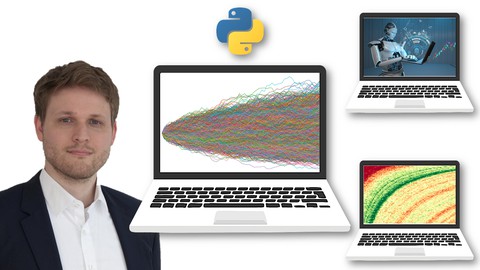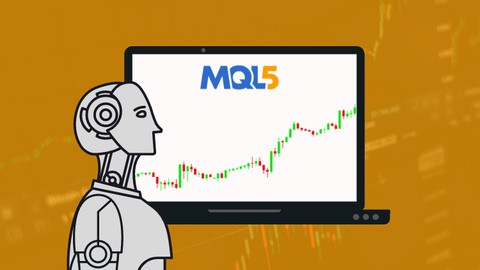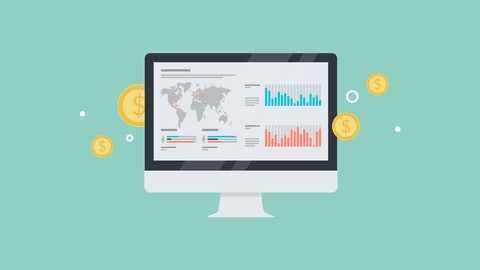Performance Optimization and Risk Management for Trading
Loại khoá học: Other Finance & Accounting
Generate Income and make a living with Day Trading / Algorithmic Trading. A quantitative & data-driven Python course.
Mô tả
(Latest course update and full code review in May 2023!)
(How) Can I generate sustainable Income and make a living with Trading? - That is one of the most frequently asked questions in Day Trading / Algorithmic Trading.
This unique course provides the skills, knowledge, and techniques required to (realistically!) answer that question. The course uses rigorous quantitative methods and is 100% data-driven (Python coding required!).
You will learn how to make use of the most powerful trading features and techniques:
Path-dependent Simulation techniques to find a sustainable level of Trading Income
Taking into account Taxation, Inflation and Shortfall Risk
Strategy Backtesting and Forward Testing
Strategy Optimization techniques (One/Many Parameter Optimization, Multi-Period Optimization, Smoothing, and more...)
Finding the optimal Degree of Leverage in Margin Trading (Kelly Criterion and more advanced techniques)
Improving Trading Performance and mange Risk with Stop Loss and Take Profits Orders
and more...
Important: these techniques and skills are highly relevant and must-knows for any Trader and any Trading activity:
for Assets like Forex (Currencies), Cryptocurrencies, Stocks, Indexes, Commodities, and more...
for Strategies based on Technical/Fundamental Analysis, Artificial Intelligence (Machine Learning & Deep Learning), Statistical Arbitrage, and more...
for Trading with Brokers like Interactive Brokers (IBKR), Binance, TD Ameritrade, Oanda, FXCM, and more...
Performance Optimization and Risk Management require... rigorous Performance and Risk Measurement. The course covers the following Metrics and Methods:
Mean-Variance Analysis
Risk-adjusted Return Metrics (e.g. Sharpe Ratio)
Downside Deviation and Sortino Ratio
Tail Risk Metrics
Maximum Drawdown, Maximum Drawdown Duration, and Calmar Ratio
Deep Analysis of Levered Trading and the Kelly Criterion
Compound Annual Growth Rate (CAGR)
Investment Multiple
and many more...
You´ll have the opportunity to practice what you have learned in various Coding Exercises/Challenges (real data and meaningful questions!).
This is not only a course on Performance and Risk Management for Trading. It´s an in-depth coding course on Python and its Data Science Libraries Numpy, Pandas, Matplotlib. You will learn how to use and master these Libraries for (Financial) Data Analysis, Optimization, and Trading.
Please note: This is not a course for complete Python Beginners (check out my other courses!)
What are you waiting for? Join now and start improving your Trading Performance!
As always, there is no risk for you as I offer a 30-Days-Money-Back Guarantee!
Thanks and looking forward to seeing you in the Course!
Bạn sẽ học được gì
How to make a living with Trading (and what it requires)
How to optimize the Performance of Trading Strategies
How to manage & control the Risk of Trading Strategies
How to find the optimal degree of Leverage for Margin Trading
How to measure the Performance and Risk of Trading Strategies and Financial Instruments
How to make proper use of Stop Loss (SL) and Take Profit (TP) Orders
Advanced Python Coding (OOP, Pandas, Numpy, Scipy, Matplotlib, Seaborn)
How to optimize Trading Performance with single/multiple Parameter Optimization
How to optimize Trading Performance with Smoothing
How to calculate Risk, Return and the Sharpe Ratio (Mean-Variance Analysis)
How to calculate Downside Risk and the Sortino Ratio
How to calculate Maximum Drawdown, Maximum Drawdown Duration and the Calmar Ratio
How to calculate CAGR, Investment Multiple, compound Returns and more.
How to generate a sustainable income with Trading
Yêu cầu
- A desktop computer (Windows, Mac, or Linux) capable of storing and running Anaconda. The course will walk you through installing the necessary free software.
- An internet connection capable of streaming HD videos.
- Basic Python Coding Skills (Variables, Data Types, Lists, For Loops, Functions) -> This is not a Course for complete Python Beginners.
- Basic Coding Skills in Pandas, Numpy and Matplotlib
- Basic Knowledge or first practical experiences with Trading/Investing would be great (not mandatory but it helps)
- Some high school level math & statistics skills would be great (not mandatory, but it helps)
Nội dung khoá học
Viết Bình Luận
Khoá học liên quan

Đăng ký get khoá học Udemy - Unica - Gitiho giá chỉ 50k!
Get khoá học giá rẻ ngay trước khi bị fix.


















Đánh giá của học viên
Bình luận khách hàng